2018 School Spending Survey Report
Reviews of select books by Marc Simont
The Happy Day by Ruth Krauss, illus.
 The Happy Day by Ruth Krauss, illus. by Marc Simont, Harper, 1949
The Happy Day by Ruth Krauss, illus. by Marc Simont, Harper, 1949The author of The Carrot Seed and Bears has once again demonstrated her ability to tell a story in the fewest possible words. Her text and Marc Simont’s fine pictures tell of the animals in the woods running because they sniff a joyful surprise—a surprise that, on the last page, will delight the reader as much as it did the animals. A distinguished book.
—Jennie D. Lindquist, from the September 1949 issue of The Horn Book Magazine.
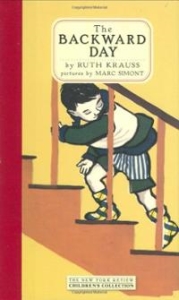 The Backward Day by Ruth Krauss, illus. by Marc Simont, Harper, 1950
The Backward Day by Ruth Krauss, illus. by Marc Simont, Harper, 1950This is the kind of nonsense little children love. “A little boy woke up one morning and got out of bed. He said to himself, ‘Today is backward day.’ He put on his coat. Over his coat, he put on his suit. Over his suit, he put on his underwear.” Marc Simont has made amusing illustrations of the little boy, with his underwear on top, and of the rest of the family and what they did on backward day.
—Jennie D. Lindquist and Siri M. Andrews, from the September 1950 issue of The Horn Book Magazine.
 A Tree Is Nice by Janice May Udry, illus. by Marc Simont, Harper, 1956
A Tree Is Nice by Janice May Udry, illus. by Marc Simont, Harper, 1956A radiant and buoyant picture book whose succession of happy thoughts and double-spreads prove to the youngest that “trees are very nice…. They make everything beautiful.” The children playing, the cows resting, the people on picnics — all appreciate trees. Humorous details and lively action contribute to the conviction that there is much for everyone to enjoy. Striking use of color, especially in the autumn spread.
—Virginia Haviland, from the April 1956 issue of The Horn Book Magazine.
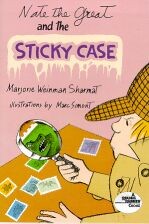 Nate the Great and the Sticky Case by Marjorie Weinman Sharmat, illus. by Marc Simont, Coward, 1978
Nate the Great and the Sticky Case by Marjorie Weinman Sharmat, illus. by Marc Simont, Coward, 1978When Claude's stamp collection is mysteriously diminished by the loss of his favorite item — a stamp depicting a stegosaurus — his friend Nate, junior-sized super sleuth, is immediately consulted. Nate follows a variety of false leads — including a trip to the local museum where he learns much about the stegosaurus and little about the stamp. Finally he remembers that the underside of an object may be as significant as its top, and this brilliant piece of deduction leads to a quick and triumphant conclusion. As in the earlier stories in the series, the easy but not controlled vocabulary is skillfully handled; and the style suggests the laconic tone frequently employed in the detective story. An appealing mystery book for the beginning reader.
—Mary M. Burns, from the October 1978 issue of The Horn Book Magazine.
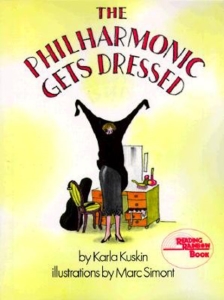 The Philharmonic Gets Dressed by Karla Kuskin, illus. by Marc Simont, Harper/Charlotte Zolotow, 1982
The Philharmonic Gets Dressed by Karla Kuskin, illus. by Marc Simont, Harper/Charlotte Zolotow, 1982Some take bubble baths; some take showers. The women put on “different kinds of complicated underwear”; the men snap suspenders into place. Finally, attired in their formal black-and-white dress, the musicians travel by cab, car, subway, or bus to midtown, where — at 8:25 on Friday night — these “one hundred and four people walk onto the big stage in Philharmonic Hall.” With marvelous attention to detail, the award-winning author and artist present a step-by-step behind-the-scenes account of an orchestra preparing for performance. In keeping with the text the artist has created subtle personalities rather than a mass of musicians: His droll color-washed drawings show individuals at their separate stages of readiness, until at last they unite to fill the hall “as wide and long as a red velvet football field” with music. An engaging treatment of an unusual subject.
—Karen Jameyson, from the October 1982 issue of The Horn Book Magazine.
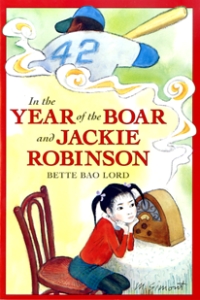 In the Year of the Boar and Jackie Robinson by Bette Bao Lord, illus. by Marc Simont, Harper, 1984
In the Year of the Boar and Jackie Robinson by Bette Bao Lord, illus. by Marc Simont, Harper, 1984Despite her cousins' warnings about the American diet of "'warm puppies and raw meat'" Bandit Wong looked forward to 1947, the Year of the Boar, when she and her mother would leave China to join Bandit's father in New York City. But the monotonous flat streets and the enigmatic white boxes that washed clothes or kept food cold made America seem "foreign, so foreign." Even though she changed her name to Shirley Temple Wong and willingly faced cultural challenges, such as roller skating and chewing bubble gum, not to mention learning English, the little girl grew discouraged. Once the glamour of being a new student faded, Shirley was practically ignored by her fifth-grade classmates — until they discovered her talent for stickball and nicknamed her Jackie RObinson after the popular baseball hero of the day. Then everything began to fall into place. Warm-hearted, fresh, and dappled with humor, the episodic book, which successfully encompasses both Chinese dragons and the Brooklyn Dodgers, stands out in the bevy of contemporary problem novels. And the unusual flavor of the text infiltrated the striking illustrations picturing the pert, pigtailed heroine making her way in Mei Guo — her new "Beautiful Country."
—Karen Jameyson, from the September/October 1984 issue of The Horn Book Magazine.

The story of Princess Lenore — who insists that she must have the moon if she is to recover from illness induced by a "surfeit of raspberry tarts" — has been a staple for reading aloud since its publication in 1943. Awarded the Caldecott Medal for Louis Slobodkin's illustrations, it is indeed a classic. Now, in a handsome new edition with pictures by Marc Simont, it assumes new vigor and vibrancy. If anything, the characters are more skillfully portrayed; Simont, who had illustrated Thurber's The Wonderful O and The Thirteen Clocks (both Simon), visually underscores the humorist's marvelously witty insights into human nature in this exaltation of the humble at the expense of the pretentious. From the doting king who would grant his daughter anything her heart desires to the capering, sympathetic court jester who solves the problem by seeking advice from the princess herself, each character is defined with a minimum of deft, sure lines in the manner of cartoon art at its best. The book is further enhanced by exquisite renderings of imagined landscapes that are like evanescent views into the land of faery. The contrast between the elegance of the watercolor medium and the absurdity of the situations matches Thurber's fluid, carefully honed prose, making this new version a remarkable accomplishment, interpreted with elán and style. With an introduction by Rosemary Thurber.
—Mary M. Burns, from the January/February 1991 issue of The Horn Book Magazine.
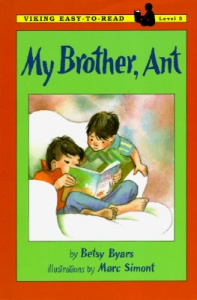 My Brother, Ant by Betsy Byars, illus. by Marc Simont, Viking/Penguin, 1996
My Brother, Ant by Betsy Byars, illus. by Marc Simont, Viking/Penguin, 1996With her hallmark humor and snappy dialogue, Betsy Byars tells four stories about a boy and his little brother Anthony, known as Ant. When Ant's brother offers to check out the monster under his bed, Ant tells him that he won't see it: "He hides from big people." His brother's response, pointing to himself, is, "THIS is a big person? Get real." Controversies over spelling homework that gets embellished with Ant's art work; a teasing version of a familiar story that Ant's brother tells about the three little figs and and the big, bad lemon; and the puzzle of a letter to Santa in July are all amicably resolved. With Marc Simont's expressive illustrations, this is a sparkling addition to the Viking Easy-to-Read series.
—Hanna B. Zeiger, from the July/August 1996 issue of The Horn Book Magazine.

This picture book has all the earmarks of a classic. The story is simple: two children play with a stray dog while on a family picnic in the country one Saturday. They don’t take him home (he might belong to someone else, say the parents), but the whole family thinks about him all week, and the next Saturday they return to the same picnic spot. The children save Willy (as they have named the dog) from the dogcatcher and adopt him, to everyone’s satisfaction and joy. Now there’s a plot that satisfies: as straightforward and cleanly shaped as, say, Harry the Dirty Dog or Corduroy. The text is spare — appropriately so, as the pictures are surpassingly eloquent. Not merely a showcase for the artist’s (considerable) prowess with watercolors, they say something. An impressionistic, bird’s-eye double-page spread of the family car crossing a bridge is breathtaking; it also tells us, wordlessly, that this is a city-dwelling family heading to the country for their picnic. The pacing is particularly impressive: in one spread, for instance, Simont gets through a whole week of action. One sentence, four spot illustrations, and — page turn — we’re on to the next Saturday, and back at the fateful picnic spot. Here, the tension builds further (with the arrival of Willy, in a blur, being chased by the dogcatcher) until it is released and transformed into happy resolution (with Willy rescued and ensconced in his new home, even being introduced at the park “to some very interesting dogs”). Having the children save Willy through their own ingenuity, by donating the girl’s hair ribbon as a leash and the boy’s belt as a collar, is almost a requirement of a good children’s book; having the little boy’s now-beltless shorts keep falling down is extra, and delightful. Over arching shape, knowledge of audience, small details-Simont gets it all right. This Stray Dog should find a home on library shelves and in readers’ hearts everywhere.
—Martha V. Parravano, from the January/February 2001 issue of The Horn Book Magazine.
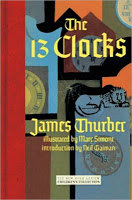 The Thirteen Clocks by James Thurber, illus. by Marc Simont, New York Review of Books, 2008 (reissue; original edition 1950)
The Thirteen Clocks by James Thurber, illus. by Marc Simont, New York Review of Books, 2008 (reissue; original edition 1950)This dark and delightful fable combines the ingredients of traditional tales--wicked duke, beautiful princess, noble prince in disguise — and comes up with a sublimely entertaining concoction. Thurber's sly humor and shameless use of puns and wordplay make the story a joy to read aloud. Simont's suitably mysterious illustrations add the perfect atmospheric touch. This reissue includes an introduction by Neil Gaiman.
— from the Spring 2009 Horn Book Guide
RECOMMENDED
ALREADY A SUBSCRIBER? LOG IN
We are currently offering this content for free. Sign up now to activate your personal profile, where you can save articles for future viewing.







Add Comment :-
Be the first reader to comment.
Comment Policy:
Comment should not be empty !!!